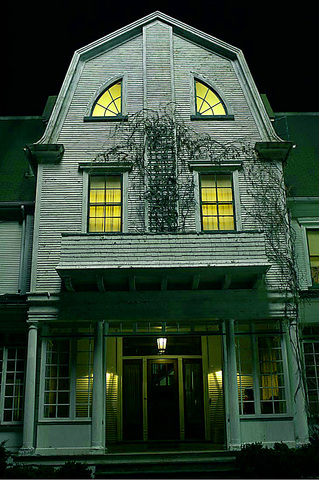In a world gone drearily mad with sequels and recycled television shows, it is merely rhetorical to ask why anyone, including the savvy part-time producer Michael Bay, would revisit a stinker like the 1979 flick The Amityville Horror.
The answer, of course, is that these days, even the dumbest horror movie scares up decent big-screen business before being shuttled off to DVD perpetuity. Just as crucial, horror is relatively cheap to churn out, especially when the supporting cast features interchangeable no-name guys and gals, and the real star of the show -- in this case, a spacious waterfront Long Island house -- doesn't require its own trailer, a piece of the gross or any of the usual perquisites.
Still, given the crushing dullness of the first Amityville Horror, it seems baffling that it had any traction at all. James Brolin, sporting a head and face full of Charles Manson fuzz, and a wild-eyed Margot Kidder play a couple who snap up a palatial Long Island house for a song. Like the audience, the lovebirds already know that their new digs are shrouded in murder and mystery, but what takes them an agonizingly long time to realize -- despite all the miscellaneous creaking and escalating weirdness -- is that the house is possessed. The movie was the kind of thing beloved by bored teenagers and recreational drug users, two occasionally overlapping demographics, and was followed by a clutch of sequels that mostly went straight to video.

PHOTO COURTESY OF THE AMITYVILLE HORROR
This latest visit to Long Island's favorite haunted house was co-produced by Bay, the director of such Jerry Bruckheimer-engineered blockbusters as Armageddon, and directed by Andrew Douglas, whose only other credit is for the provocatively titled Searching for the Wrong-Eyed Jesus. Douglas takes an instrumental approach to the material, meaning he does what he can in as slickly commercial a fashion as possible. The writer this time is Scott Kosar, who also wrote Bay's equally serviceable remake of The Texas Chainsaw Massacre and more interestingly, Brad Anderson's Machinist. Kosar builds on the story arc of the first Amityville, which shrouded a gruesome real-life multiple murder in a bunch of supernatural hooey, and predictably pumps up the gory violence. Don't get too attached to the family dog.
Set in the 1970's, the new Amityville stars an effective Ryan Reynolds as George Lutz, the hirsute paterfamilias with an easy smile and an unsettling fondness for chopping wood. Melissa George plays his wife, a widow and mother of three who, having recently married again, is still trying to get it right for her young brood and her new man. Despite the jittery realty agent, and an ugly stain marring a large swath of ceiling downstairs, and, oh yeah, the nasty revelation about the house being the site of a murderous family meltdown, the Dutch Colonial home looks like the American dream to the young couple. They take the homeowners' plunge, thereupon triggering various unfortunate events and, in time, a serious case of buyer's remorse.
Low-key creepy rather than outright scary, the new Amityville marks a modest improvement over the original, partly because, from acting to bloody effects, it is better executed, and partly because the filmmakers have downgraded the role of the priest, played in all his vein-popping glory by Rod Steiger in the first film and by a considerably more subdued Philip Baker Hall here. Oddly, with these improvements, the filmmakers have removed Amityville from the realm of kitsch, perhaps with unintended results. In 1974, when a Long Island man turned Amityville into a crime scene by killing his family, there was something so novel about this kind of tragedy that it could be spun into a pop-cultural myth. These days, with the tight real estate market, I realized I didn't care one bit about anyone making it out alive -- I wanted the house.
The Amityville Horror contains bloody violence, including gruesome images of torture and the murder of a family pet; some viewers may be disturbed by the family dynamics.

From the last quarter of 2001, research shows that real housing prices nearly tripled (before a 2012 law to enforce housing price registration, researchers tracked a few large real estate firms to estimate housing price behavior). Incomes have not kept pace, though this has not yet led to defaults. Instead, an increasing chunk of household income goes to mortgage payments. This suggests that even if incomes grow, the mortgage squeeze will still make voters feel like their paychecks won’t stretch to cover expenses. The housing price rises in the last two decades are now driving higher rents. The rental market

July 21 to July 27 If the “Taiwan Independence Association” (TIA) incident had happened four years earlier, it probably wouldn’t have caused much of an uproar. But the arrest of four young suspected independence activists in the early hours of May 9, 1991, sparked outrage, with many denouncing it as a return to the White Terror — a time when anyone could be detained for suspected seditious activity. Not only had martial law been lifted in 1987, just days earlier on May 1, the government had abolished the Temporary Provisions Effective During the Period of National Mobilization for Suppression of the Communist

When life gives you trees, make paper. That was one of the first thoughts to cross my mind as I explored what’s now called Chung Hsing Cultural and Creative Park (中興文化創意園區, CHCCP) in Yilan County’s Wujie Township (五結). Northeast Taiwan boasts an abundance of forest resources. Yilan County is home to both Taipingshan National Forest Recreation Area (太平山國家森林遊樂區) — by far the largest reserve of its kind in the country — and Makauy Ecological Park (馬告生態園區, see “Towering trees and a tranquil lake” in the May 13, 2022 edition of this newspaper). So it was inevitable that industrial-scale paper making would

Hualien lawmaker Fu Kun-chi (傅?萁) is the prime target of the recall campaigns. They want to bring him and everything he represents crashing down. This is an existential test for Fu and a critical symbolic test for the campaigners. It is also a crucial test for both the Chinese Nationalist Party (KMT) and a personal one for party Chairman Eric Chu (朱立倫). Why is Fu such a lightning rod? LOCAL LORD At the dawn of the 2020s, Fu, running as an independent candidate, beat incumbent Democratic Progressive Party (DPP) lawmaker Hsiao Bi-khim (蕭美琴) and a KMT candidate to return to the legislature representing